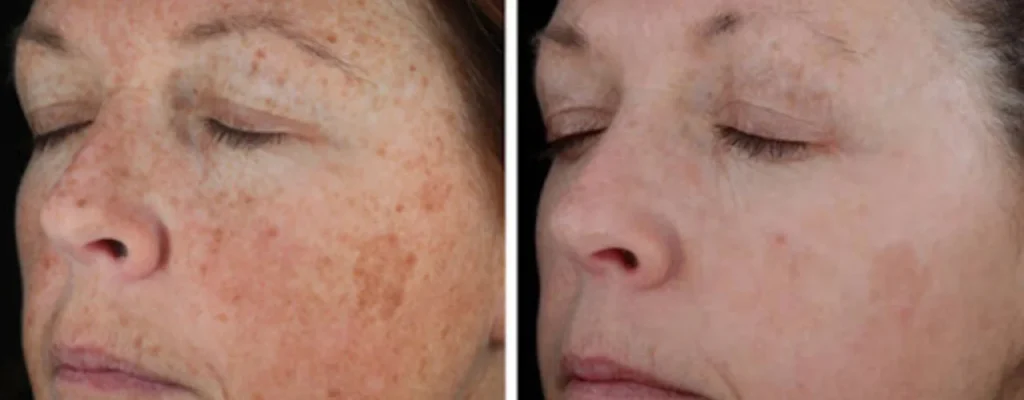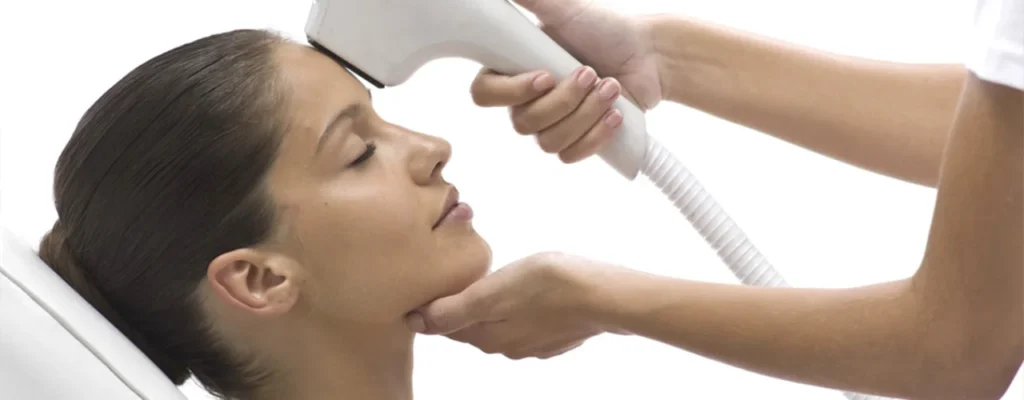No More Damage: How IPL Can Erase Years from Your Face

Intense pulsed light (IPL) is a broad-spectrum light therapy that uses pulses of polychromatic, non-coherent light of visible and near-infrared wavelengths. It is a gentle, non-invasive skin treatment that is used to address a variety of skin concerns, including:
- Sun damage, such as age spots, sun spots, and wrinkles
- Acne
- Rosacea
- Spider veins
- Unwanted hair
- Freckles
- Melasma
- Scarring
How does IPL work?

IPL works by targeting specific chromophores in the skin, such as melanin (pigment) in freckles and sun spots, or hemoglobin (blood) in spider veins. The light energy is absorbed by the chromophore, which heats up and damages the tissue. The body then naturally removes the damaged tissue, resulting in a clearer, more even-toned complexion.
IPL treatments are typically performed by a dermatologist or aesthetician. The procedure is relatively quick and painless, and most patients require 3-6 treatments spaced 4-6 weeks apart to achieve optimal results.
Here are some of the benefits of IPL:
- It is a safe and effective treatment for a variety of skin concerns.
- It is a non-invasive and non-ablative treatment, meaning that it does not damage the top layer of skin.
- It is relatively quick and painless.
- There is minimal downtime after treatment.
Risks and side effects associated with IPL:
- Skin redness and swelling
- Hyperpigmentation or hypopigmentation
- Blistering
- Scarring
It is important to consult with a certified dermatologist or aesthetician to determine if IPL is right for you and to discuss the potential risks and side effects.
Additional Resources:
- American Academy of Dermatology: https://www.hirschplasticsurgery.com/Intense-pulsed-light
- Mayo Clinic: https://www.mayoclinic.org/tests-procedures/laser-hair-removal/doctors-departments/pdc-20394556
- National Health Service (UK): https://www.pulselightclinic.co.uk/rosacea/rosacea-nhs-treatments-ineffective
- Skin Cancer Foundation: https://www.skincancer.org/
IPL Photorejuvenation: Your Gateway to Radiant Skin

IPL photorejuvenation is a game-changer in the world of cosmetic skincare, offering a non-invasive solution to a multitude of skin concerns. It’s like a magic light wand that erases the tell-tale signs of aging and sun damage, leaving you with a more youthful, even-toned complexion.
Ready to say goodbye to:
- Fine lines and wrinkles
- Age spots and sun spots
- Uneven skin tone and redness
- Visible pores and enlarged pores
- Rosacea symptoms like redness and irritation
- Spider veins
Here’s how IPL photorejuvenation works its magic:
- Broad-spectrum light pulses target specific chromophores (pigment or hemoglobin) in your skin.
- The light energy heats up these chromophores, causing controlled damage.
- Your body naturally removes the damaged tissue, revealing clearer, rejuvenated skin.
Benefits of IPL photorejuvenation:
- Safe and effective: Suitable for various skin types and concerns.
- Non-invasive: No needles or incisions, minimal discomfort.
- Quick and convenient: Treatment sessions are typically under 30 minutes.
- Minimal downtime: Get back to your regular routine quickly.
- Long-lasting results: Enjoy a younger, refreshed look for months to come.
But before you rush into the light, consider these points:
- Consult a board-certified dermatologist or aesthetician for personalized advice.
- Understand potential side effects like temporary redness, swelling, or hyperpigmentation.
- Multiple sessions may be necessary for optimal results.
Additional resources:
- American Academy of Dermatology: https://www.aad.org/public/ipledge-story
- Mayo Clinic: https://evolvemedspadallas.com/blog/can-i-wear-makeup-after-ipl-therapy
- WebMD: https://www.webmd.com/beauty/intense-pulsed-light-treatment-overview
IPL for vascular lesions:

Intense pulsed light (IPL) is a non-invasive light therapy treatment that uses broad-spectrum, high-intensity light pulses to target and destroy unwanted blood vessels in the skin. This makes it an effective treatment for a variety of vascular lesions, including:
- Spider veins: These are thin, red or blue veins that often appear on the face and legs.
- Rosacea: This is a skin condition that causes redness, flushing, and small, visible blood vessels on the face.
- Port-wine stains: These are red birthmarks caused by malformed blood vessels.
- Hemangiomas: These are raised, red birthmarks that can grow rapidly in infancy.
How does IPL work?
The IPL device emits flashes of light that are absorbed by the hemoglobin in the blood vessels. This absorption causes the blood vessels to heat up and coagulate, which closes them off. Once the blood vessels are closed, the vascular lesion fades and eventually disappears.
Benefits of IPL for vascular lesions:
IPL offers several benefits over other treatments for vascular lesions, such as:
- Non-invasive: No surgery or injections are required.
- Minimal downtime: Most patients can return to their normal activities immediately after treatment.
- Effective for a variety of lesions: IPL can be used to treat a wide range of vascular lesions, from spider veins to port-wine stains.
- Safe for most skin types: IPL is generally safe for all skin types, although darker skin tones may be more prone to side effects.
Risks and side effects of IPL:
- Redness
- Swelling
- Bruising
- Scabbing
More serious side effects are rare, but can include:
- Blistering
- Infection
- Scarring
Is IPL right for you?
If you are concerned about vascular lesions, you should talk to a board-certified dermatologist or plastic surgeon to see if IPL is right for you. They can assess your skin and determine if IPL is the best treatment option for you.
Some additional things to keep in mind:
- IPL is not a cure for vascular lesions. Some lesions may require multiple treatments.
- IPL is not effective for all types of vascular lesions.
- IPL is not recommended for pregnant or breastfeeding women.
IPL For Hair Removal:

IPL for hair removal! It’s a popular treatment that uses pulses of light to target and damage hair follicles, leading to hair growth reduction and potential long-term hair removal.
Here’s how it works:
- The IPL device emits flashes of broad-spectrum light.
- The melanin in your hair follicles absorbs the light.
- The absorbed light converts to heat, damaging the hair follicle.
- Damaged follicles produce thinner, finer hair, or stop producing hair altogether.
Benefits of IPL hair removal:
- Effective for various hair colors and skin types: IPL works best on light to medium skin tones with dark hair, but advancements in technology are making it more effective for a wider range of skin and hair types.
- Long-lasting results: While not permanent, it can significantly reduce hair growth for months or even years.
- Relatively painless: Most people describe IPL as feeling like a warm flick or rubber band snap.
- Convenient: Treatments can be done at home with handheld devices or professionally in a spa or clinic.
Things to consider:
- Multiple treatments are usually needed: Depending on your hair growth and desired results, you may need 4-12 treatments spaced 4-6 weeks apart.
- Not effective for all hair: Fine, white, or gray hair may not respond well to it.
- Potential side effects: These are usually mild and temporary, such as redness, swelling, or irritation. In rare cases, blistering or scarring can occur.
Additional tips for safe and effective IPL hair removal:
- Consult a dermatologist or licensed professional before starting treatment. They can assess your suitability for IPL and recommend the best settings for your skin and hair type.
- Follow the manufacturer’s instructions carefully when using a home IPL device.
- Avoid sun exposure before and after treatment.
- Use sunscreen regularly to protect your skin.
IPL for acne management:

It can be a helpful tool in managing acne, but it’s important to understand its capabilities and limitations before diving in. Here’s a breakdown:
How IPL works for acne:
- Targets acne bacteria: The light energy from IPL targets the bacterium Propionibacterium acnes (P. acnes), which contributes to acne breakouts. The light heats and destroys the bacteria, reducing its ability to cause inflammation and breakouts.
- Reduces sebum production: It can also target the sebaceous glands, which produce sebum (oil). Excessive sebum buildup can clog pores and contribute to acne. By reducing sebum production, It can minimize future breakouts.
- Improves skin texture: Certain wavelengths of IPL light can stimulate collagen production, which leads to improved skin texture and potentially reduces the appearance of acne scars.
Benefits of IPL for acne:
- Non-invasive and minimal downtime: Unlike some acne treatments, it doesn’t involve injections or surgery, and there’s minimal downtime after treatment.
- Effective for various acne types: It can be helpful for inflammatory acne, including papules, pustules, and nodules.
- Potentially reduces scarring: By targeting both active acne and scar tissue, IPL may help minimize the appearance of existing scars and prevent future scarring.
Things to consider:
- Not a cure: It doesn’t permanently cure acne, and multiple sessions are often needed to maintain results.
- Not effective for all acne: It is less effective for non-inflammatory acne like blackheads and whiteheads.
- Potential side effects: While generally safe, It can cause temporary redness, swelling, and irritation. More serious side effects like blistering and scarring are rare but possible.
- Not suitable for everyone: People with dark skin tones, active infections, or certain medical conditions may not be suitable for IPL.
Recommendations:
- Consult a dermatologist: Before starting it, it’s crucial to consult a certified dermatologist to assess your suitability for the treatment and determine the best course of action.
- Realistic expectations: Understand that it is a gradual process, and noticeable improvement may take several sessions.
- Follow aftercare instructions: After treatment, your dermatologist will provide specific instructions on how to care for your skin to optimize results and minimize side effects.
Overall, it can be a valuable tool for managing acne, but it’s important to approach it with realistic expectations and under the guidance of a qualified professional. I hope this information helps you make an informed decision about whether it is right for you!
Additional resources:
American Academy of Dermatology: https://www.aad.org/public/diseases/acne
Mayo Clinic: https://www.mayoclinic.org/diseases-conditions/acne/diagnosis-treatment/treatment/txc-20368093
Skin Cancer Foundation: https://walkindermatology.com/ipl-photofacials-for-acne/
Conclusion:
Intense pulsed light (IPL) emerges as a versatile tool for addressing various skin concerns, from unwanted hair to acne and vascular lesions. While not a magic bullet, it offers a non-invasive and often effective option for improvement. However, individual results and suitability vary greatly. Consulting a qualified professional is crucial to understand its capabilities, limitations, and potential risks to ensure safe and effective treatment tailored to your specific needs.
Derma and Dental Clinic:
Derma & Dental Clinic stands out with its team of experienced doctors backed by scientific evidence in their chosen fields. Their diverse range of medical-grade procedures offer tailored solutions for various skin and dental needs. You can confidently book your consultation online or by phone and embark on your journey towards healthier skin and a radiant smile.
Location: Bahria Town, Lahore
Specialties: Dermatology and Dental Care
Website: derma.pk
For Consultation:
- Online at Dermatology.pk
- WhatsApp: +923205999650
- Phone: 03041115000



